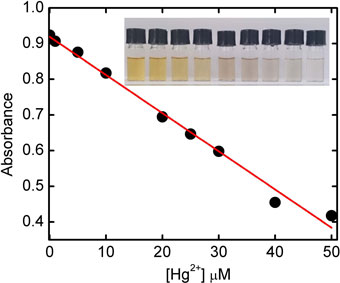Crossref Citations
This article has been cited by the following publications. This list is generated based on data provided by Crossref.
ul Ain, Noor
Anis, Itrat
Ahmed, Farid
Shah, Muhammad Raza
Parveen, Samina
Faizi, Shaheen
and
Ahmed, Shakil
2018.
Colorimetric detection of amoxicillin based on querecetagetin coated silver nanoparticles.
Sensors and Actuators B: Chemical,
Vol. 265,
Issue. ,
p.
617.
Thiyagarajan, Kalaiyarasan
Bharti, Vijay K.
Tyagi, Shruti
Tyagi, Pankaj K.
Ahuja, Anami
Kumar, Krishna
Raj, Tilak
and
Kumar, Bhuvnesh
2018.
Synthesis of non-toxic, biocompatible, and colloidal stable silver nanoparticle using egg-white protein as capping and reducing agents for sustainable antibacterial application.
RSC Advances,
Vol. 8,
Issue. 41,
p.
23213.
Liu, Xun
Li, Kangxin
Wu, Chaoqun
Zhou, Yong
and
Pei, Chonghua
2019.
Egg white-assisted preparation of inorganic functional materials: A sustainable, eco-friendly, low-cost and multifunctional method.
Ceramics International,
Vol. 45,
Issue. 18,
p.
23869.
ul Ain, Noor
Aslam, Zara
Yousuf, Muhammad
Waseem, Waqas Ahmed
Bano, Samina
Anis, Itrat
Ahmed, Farid
Faizi, Shaheen
Malik, Muhammad Imran
and
Shah, Muhammad Raza
2019.
Green synthesis of methyl gallate conjugated silver nanoparticles: a colorimetric probe for gentamicin.
New Journal of Chemistry,
Vol. 43,
Issue. 4,
p.
1972.
Sabouri, Zahra
Akbari, Alireza
Hosseini, Hasan Ali
Khatami, Mehrdad
and
Darroudi, Majid
2020.
Egg white-mediated green synthesis of NiO nanoparticles and study of their cytotoxicity and photocatalytic activity.
Polyhedron,
Vol. 178,
Issue. ,
p.
114351.
Paw, Rintumoni
Hazarika, Moushumi
Boruah, Purna K.
Kalita, Amlan Jyoti
Guha, Ankur K.
Das, Manash R.
and
Tamuly, Chandan
2021.
Highly sensitive and selective colorimetric detection of dual metal ions (Hg2+and Sn2+) in water: an eco-friendly approach.
RSC Advances,
Vol. 11,
Issue. 24,
p.
14700.
Buledi, Jamil Ahmed
Amin, Sidra
Haider, Syed Iqleem
Bhanger, Muhammad Iqbal
and
Solangi, Amber R.
2021.
A review on detection of heavy metals from aqueous media using nanomaterial-based sensors.
Environmental Science and Pollution Research,
Vol. 28,
Issue. 42,
p.
58994.
Rasheed, Tahir
Shafi, Sameera
Ali, Jazib
Sher, Farooq
Rizwan, Komal
and
Khan, Salahuddin
2022.
Recent advances in chemically and biologically synthesized nanostructures for colorimetric detection of heavy metal.
Journal of King Saud University - Science,
Vol. 34,
Issue. 2,
p.
101745.
Paikrao, Hariprasad Madhukarrao
Tajane, Diksha Suryabhan
Patil, Anita Surendra
and
Dipale, Ashlesha Dipak
2022.
Engineered Nanomaterials for Innovative Therapies and Biomedicine.
p.
257.
Garg, Diksha
Singh, Damnita
Sharma, Rajni
Verma, Neelam
Bhari, Ranjeeta
and
Asadnia, Mohsen
2022.
Green Chemical Analysis and Sample Preparations.
p.
471.
Jayeoye, Titilope John
Sirimahachai, Uraiwan
Wattanasin, Panwadee
and
Rujiralai, Thitima
2022.
Eco-friendly poly(aniline boronic acid)/gum tragacanth stabilized silver nanoparticles nanocomposite for selective sensing of Hg2+.
Microchemical Journal,
Vol. 182,
Issue. ,
p.
107949.
Sahu, Mamta
Ganguly, Mainak
and
Sharma, Priyanka
2024.
Role of silver nanoparticles and silver nanoclusters for the detection and removal of Hg(ii).
RSC Advances,
Vol. 14,
Issue. 31,
p.
22374.
Hashim, Asmaa R.
Bashir, Dina W.
Rashad, Eman.
Galal, Mona K.
Rashad, Maha M.
Deraz, Nasrallah M.
Drweesh, Elsayed A.
and
El-Gharbawy, S. M.
2024.
Alleviative effect of betaine against copper oxide nanoparticles-induced hepatotoxicity in adult male albino rats: histopathological, biochemical, and molecular studies.
Beni-Suef University Journal of Basic and Applied Sciences,
Vol. 13,
Issue. 1,
Sunny, Annrose
Venkataramana, Kasarapu
Ranjith Kumar, Y.
and
Vasundhara, M.
2025.
Low and high temperature magnetic properties of MgFe2O4 nanoparticles synthesized by a simple egg white albumin route.
Journal of Crystal Growth,
Vol. 662,
Issue. ,
p.
128174.


